If you’re a regular at your local coffee spot, you’ve probably heard these two drinks tossed around more times than you can count.
But do you really know the difference between “latte vs mocha”? The answer is definitely “No” (otherwise, you wouldn’t land on this post!). Well, you’re not alone.
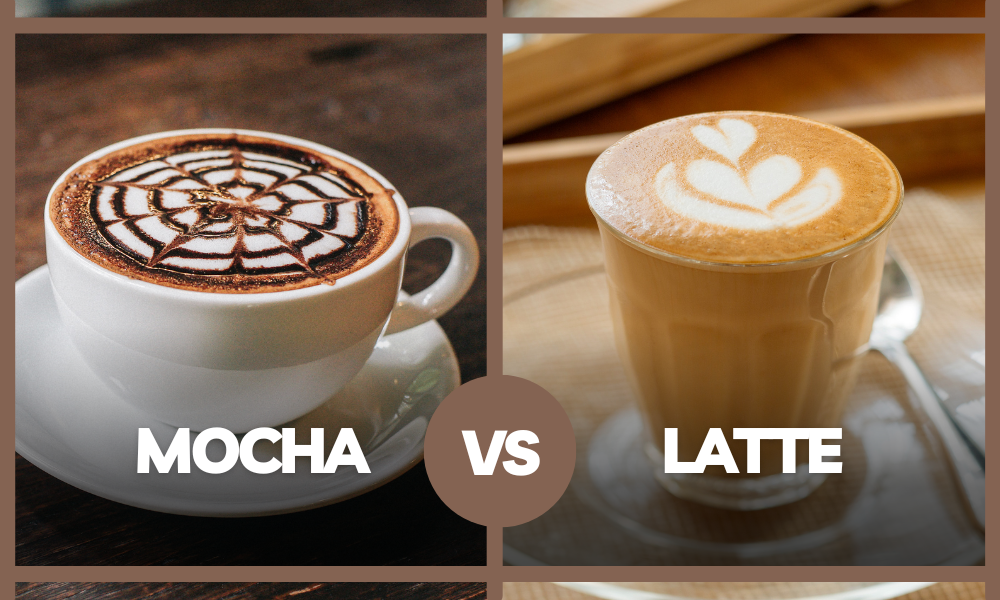
These two popular coffee drinks have a lot in common, but some key differences set them apart.
A latte is made with espresso, steamed milk, and a small amount of foam on top, while a mocha is made with espresso, steamed milk, chocolate syrup or powder, and whipped cream. The main difference is that a latte is primarily a coffee-based drink, while a mocha has a stronger chocolate flavor.
However, that’s not all! There are other differences regarding their origins, taste, caffeine content, how they’re made, and how they’re served in different coffee shops.
Well, grab a cup of Joe and get ready to take notes because we’re about to break it down for you in the most entertaining way possible.
What Goes into Caffè Latte?
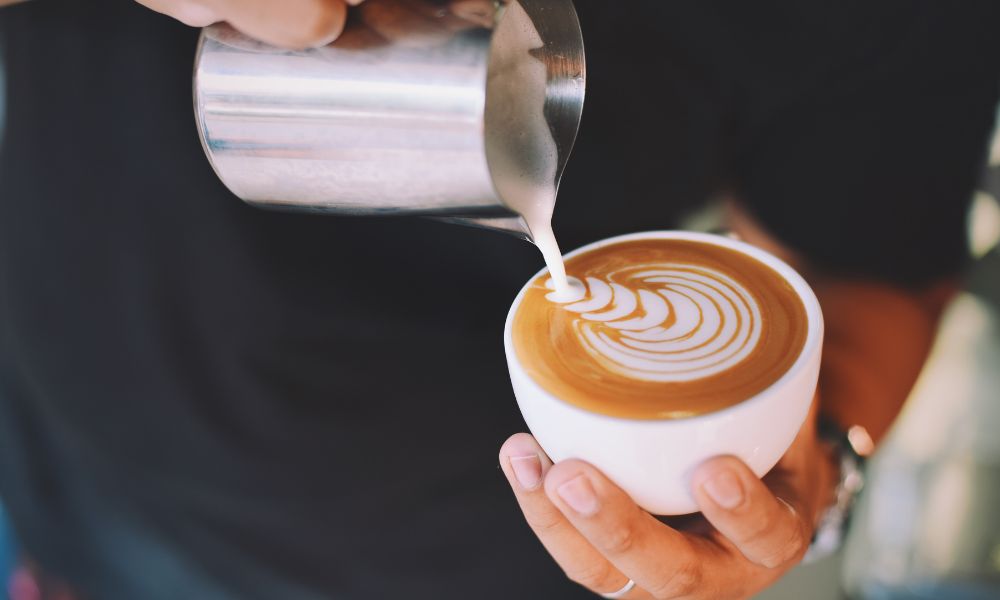
First, let’s just state the obvious – Lattes are everywhere. They’re like the little black dress of the coffee world, always in style and always a crowd-pleaser.
And the best part? They’re relatively easy to make.
Some places will serve it in a tall glass, while others will serve it in a regular cup. But no matter how it’s served, a Latte is always a smooth and subtle sweet treat.
Now, the traditional recipe for a Latte is simple, it’s just a shot of espresso, steamed milk, and 2-3 cm of foamed milk. But let’s not forget, some baristas out there are real artists, and they’ll create some latte art that will blow your mind.
But here’s the thing, Lattes have evolved, and now you have all sorts of variations like Matcha Lattes, Chai Latte, and even a Chocolate Latte (which is like a Mocha’s cousin).
And if you’re feeling adventurous, you can even order a whipped coffee cocktail called a Dalgona Latte.
Now, the word Latte itself comes from the Italian word “caffe latte” which means coffee and milk. But nowadays you can order a Latte with all sorts of ingredients.
You can even find Turmeric Lattes and Sweet Potato Lattes in some Asian places.
And here’s the best part, you can even make it a little healthier by ordering it with plant-based milk like almond milk, oat milk, or soy milk.
Because let’s face it, a lot of us are lactose intolerant and it’s not fun to have a stomachache after a delicious Latte.
When Is the Best Time to Order a Latte?
Any time of the day! But, just a heads up, in Italy, Lattes are typically ordered as a breakfast coffee.
So, if you’re in Italy, and you want to order a Latte for lunch or dinner, be prepared to get some weird looks. But hey, who cares about traditional rules when it comes to coffee, right?
Another thing to remember when you’re in Italy: say “caffe latte” instead of “latte”. Otherwise, you may be served just milk which is the meaning of “latte” in Italian!
So, What Is the Caffè Mocha?
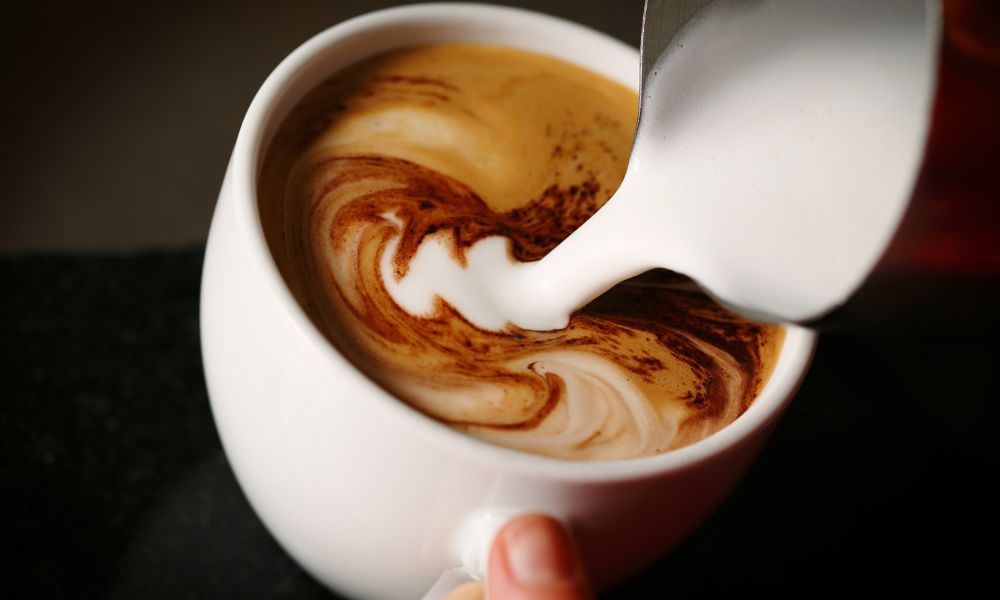
Let’s talk about the Mocha – the drink that’s like the Latte’s wild and adventurous cousin.
Now, you might be thinking, “Hey, wait a minute, isn’t Mocha just a caffeine-free drink?” Well, that’s a myth! The traditional Mocha is made with a shot of espresso, milk, and a little bit of hot chocolate magic.
Now, what makes Mocha so darn delicious is that dark or milk chocolate. It’s like a Latte and hot chocolate had a baby and that baby grew up to be a Mocha coffee drink.
But let’s be real here, all that chocolate also means more sugar. So, if you’re thinking about making Mocha your daily go-to drink, think again.
Mocha is best enjoyed as an occasional treat. And if you’re feeling fancy, you can even make it with hot white chocolate, making it even more irresistible.
During the winter holidays, coffee shops start to sell all sorts of Mocha drinks, like hot chocolate and mint, chocolate hazelnut, salted caramel, and even chocolate and black forest gateaux syrup.
And let’s not forget, mainstream coffee shops will also add cream to Mocha, making it even more delicious and indulgent.
When Do People Drink Mocha?
Mocha is another type of coffee drink that is often considered a morning drink because of its satisfying quality. It may be a good option as a mid-morning beverage paired with a light snack.
If you’re looking for a seasonal variation, just wait for the holiday season, it’s the best time to try different Mocha variations.
History and Origin
Origin of the Caffè Latte

The term “caffé latte” is Italian for “milk coffee” and it’s interesting to note that in Scandinavia and Northern Europe, the term “café au lait” is used to refer to a combination of milk and espresso – a latte.
However, historians and the Oxford English Dictionary credit the first use of the term “caffé lato” or “caffé latte” to William Dean Howells’ essay “Italian Journeys”.
Despite this historical background, the modern commercial latte is often considered an American invention.
Some believe that the latte was created to cater to American tourists who wanted a more palatable option compared to the stronger taste of Italian espresso.
The American version is thought to have originated in California and gained popularity in Seattle – the American capital of coffee – in the 1980s.
Origins of the Mocha
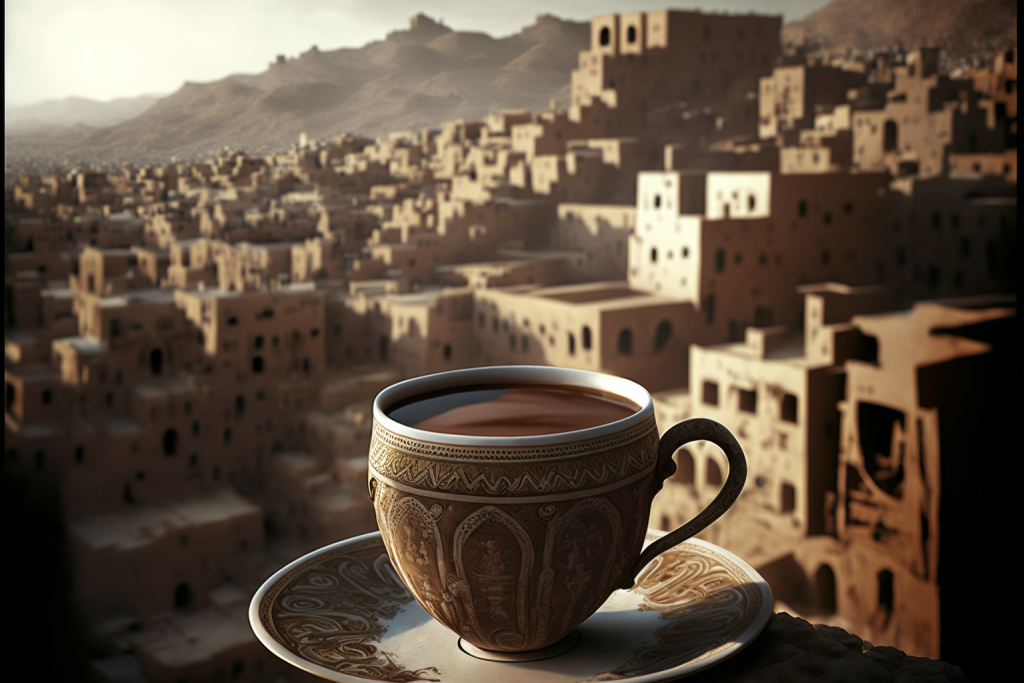
The city of Mocha, also known as Al-Mokha, in Yemen is the origin of the term “mocha coffee.”
Historically, Yemen was a major supplier of coffee to Europe, with beans transported by sea through the port of Al-Mokha before reaching the European markets.
The Dutch East India Company was one of the merchants that imported the coffee and marketed it as “mocha” coffee, referencing the city of origin. Eventually, the term “mocha” became synonymous with coffee.
But why does mocha today often refer to a chocolate coffee blend?
While mocha beans were said to have a natural chocolate flavor, today’s mocha is a combination of coffee, milk, and chocolate.
Some sources suggest that the modern American version of the mocha, which includes milk and chocolate, can be traced back to an Italian drink called bicerin, which was traditionally served in a clear glass with visible layers of espresso, chocolate, and milk.
Americans adopted this drink and eliminated the layered presentation resulting in the popular café mocha we know today.
Latte vs Mocha – What’s the Difference?
Understanding the characteristics of each drink will help you in determining which drink aligns better with the taste you’re looking for.
| Latte | Mocha | |
| Brewing Method | Espresso machine to brew the espresso shots | Espresso machine to brew the espresso shots |
| Taste and Flavors | A latte coffee usually has a sweet, creamy taste with notes of vanilla and caramel. | A mocha has a stronger chocolate flavor |
| The Look | A latte has a higher milk-to-espresso ratio and is often served in a clear glass cup | A mocha is typically served with whipped cream or chocolate shavings |
| Caffeine Content | One shot contains 68mg of caffeine | Mocha has higher caffeine content because of the added dark chocolate |
1. Brewing Method
Both lattes and mochas require an espresso machine to brew the espresso shots.
To make a mocha, the espresso shots are pulled, and an equal amount of chocolate is mixed into the espresso while the milk steams. Once the milk is steamed, it is poured over the top and whipped cream can be added as desired.
To prepare a latte, shots are brewed, and steamed milk is poured over the top. The latte is often finished with a layer of milk foam or art. If you want to add flavor, it is typically added after the espresso and before the milk foam.
Many modern espresso machines come with pre-programmed recipes, making it easy to make a latte with just one touch.
2. Taste and Flavors
A mocha has a stronger chocolate flavor than a latte due to the addition of chocolate sauce. It may also have undertones of caramel or vanilla. The texture is usually rich, and the aftertaste tends to be bittersweet.
A latte coffee usually has a sweet, creamy taste with notes of vanilla and caramel. The espresso flavor is also usually present, giving a slightly bitter and roasted taste to the drink.
For the best flavor profile, use beans that have been roasted to a medium-dark brown color. This will provide a robust taste without being too overpowering.
I recommend checking out my suggestions for the best coffee beans for your latte. These beans can also be used to make mocha at home.
3. The Look
The contrast between a mocha and a latte is quite distinct, especially when prepared by a professional barista in a coffee shop setting.
A mocha is typically served with whipped cream or chocolate shavings, and even without these toppings, it is generally darker in color compared to a latte.
In contrast, a latte has a higher milk-to-espresso ratio and is often served in a clear glass cup, making its lighter color more obvious. Additionally, art on top of a latte is a common feature.
4. Caffeine Content
Both lattes and mochas are espresso-based coffee drinks, which have a higher caffeine content than regular coffee beans.
For a sweet, smooth flavor, the best latte is made with one espresso shot. For a mocha, you can choose one or two espresso shots. One shot contains 68mg of caffeine.
Generally, mocha has higher caffeine content because of the added dark chocolate, which also contains caffeine.
Is Latte Healthier Than Mocha? (Which Has More Calories?)
The Mocha is a little bit of a calorie bomb. It’s like the “I-ate-the-whole-pint-of-ice-cream” of the coffee world. But don’t worry, if you’re watching your waistline, the skinny latte is here to save the day. It’s like the “I-only-had-a-scoop” of the coffee world.
Now, when it comes to calorie count, the Mocha has more calories because it has chocolate added to it. A skinny latte has fewer calories because it only has espresso and low-fat milk.
A typical latte has 43 calories per 100g, and a Mocha has 64 calories per 100g. But here’s a fun fact – the Latte has more fat in it because it has more milk.
If you are following a low-carb diet like keto, it’s best to avoid Mocha as it has more cars than a Latte.
In terms of health benefits, a Latte is good for people who want more calcium and protein in their diet because it has more milk.
If you’re counting your calories, stick to an Americano, it’s like the “I-had-a-glass-of-water” with just one lonely little calorie per 100g.
But, if you’re feeling adventurous and want to indulge, go for a Frappuccino; it has 67 calories per 100g.
How to Make a Mocha at Home?
Making a Mocha at home is simple, you just need some basic ingredients, such as espresso, any syrup or flavor of your choice, and milk (in ⅖:⅖:⅕ ratio).
- To start, take a cup and add chocolate, syrup, or a flavor of your choice to fill about a quarter of the cup.
- Then add espresso to the cup, mixing it in.
- Next, fill the rest of the cup with equal parts steamed milk and frothed milk.
- Give it a gentle mix and your homemade Mocha is ready!
You can adjust the sweetness or flavor to your liking. This is an easy and perfect way to make Mocha at home.
How to Make Latte at Home?
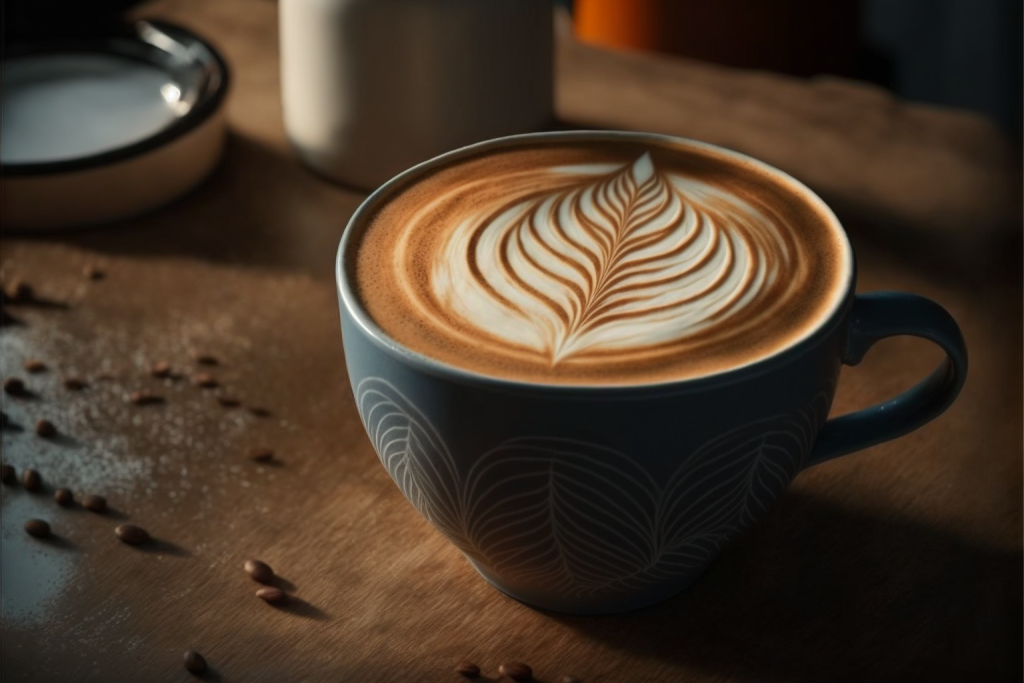
Making a Latte at home is just as easy as making a Mocha, as long as you know the proper technique. The ingredients you need are espresso and milk.
While the ideal ratio is 1:2, Lattes are typically made with more milk than espresso.
- To make a perfect Latte, start by adding an espresso shot (or double shot if you prefer it stronger) into a large ceramic cup or latte cup.
- Next, prepare steamed milk by heating it on a burner on medium flame and pour it into the cup until it’s nearly full (keep space for the foamed milk).
- Then, add a layer of milk foam on top of the steamed milk.
- Gently tilt the cup to mix the milk with the espresso. For a final touch, you can sprinkle cocoa powder on top.
Sometimes you go to a coffee shop, and you see those fancy designs on top of your latte; that’s called latte art.
And let me tell you, it’s not as easy as it looks. But if you’re feeling creative and have an eye for art, give it a try!
But if you’re not feeling like a Picasso with your latte, don’t worry, a simple cocoa powder garnish on top works just as well.
Milk for Latte and Mocha Coffees
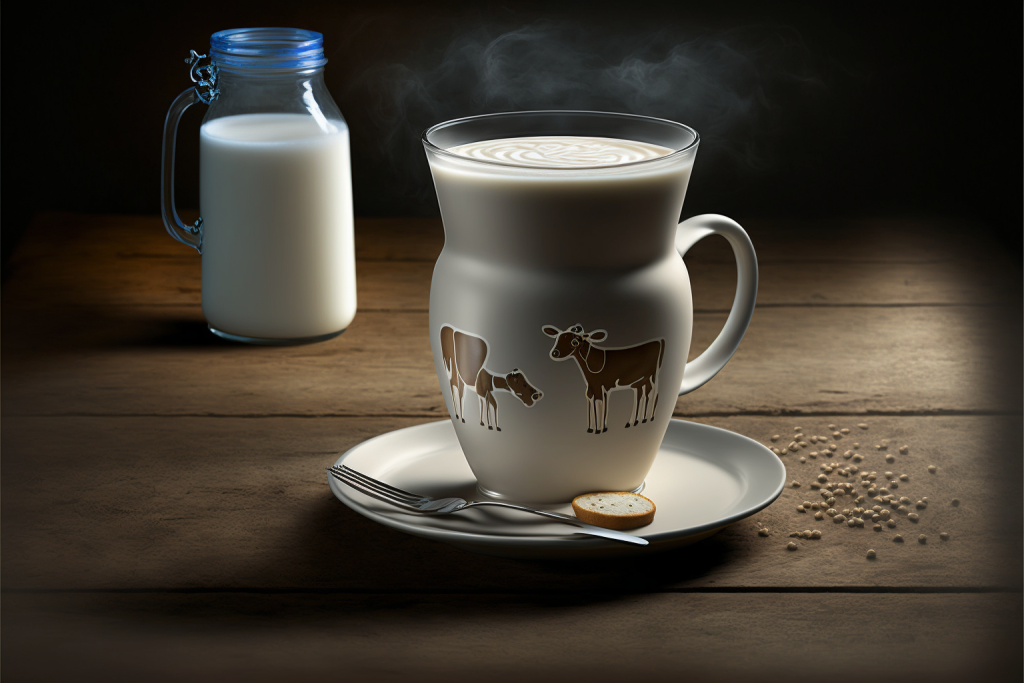
As you’ve noticed from the recipes, both Latte and Mocha coffee drinks use steamed and/or frothed milk.
While making the espresso shots is a breeze with a good espresso machine, preparing the perfect milk is whole work of art!
To make this milk, you can use the steam wand on an espresso machine or a milk frothing device.
The main difference between frothed milk and steamed milk is the number of air bubbles they have. Frothed milk has double the volume of air bubbles than steamed milk.
Steamed Milk
To make steamed milk, you place the steam wand about an inch into cold milk and create a whirlpool effect.
Keep steaming until the milk reaches between 145°F and 155°F (check with a thermometer). You may read this guide on the science of steamed milk to understand why!
Frothed Milk
To make frothed milk, you place the milk frother into the milk to mix air into the milk to produce an airy layer of froth.
As the milk starts to foam on the surface, you move the wand down through the milk until it reaches the bottom of the cup.
The froth forms as the milk volume expand and you need to move the wand further down. Do a little bit of practice, and you’ll get used to using it.
Iced Mocha vs Latte
Both hot and iced versions of lattes and mochas are popular throughout the year, but iced lattes and iced mochas are particularly in demand during warmer months.
It’s important to note that adding hot espresso directly to ice is not recommended as it can cause the espresso to become bitter and melt the ice too quickly. To make iced espresso-based drinks, the espresso shots should be mixed with milk and/or chocolate before adding ice.
The steps to make an iced latte are:
- Begin by adding cold milk to a glass or to-go cup
- Next, pour the desired amount of espresso shots into the milk and mix well.
- Lastly, top off the drink with ice.
To make an iced mocha, the steps are:
- Start by placing cold milk in a glass or to-go cup
- Mix the espresso shots with an equal amount of chocolate syrup
- Pour the mixture of espresso and chocolate into the milk and stir to combine.
- Finally, add ice to the cup, and your iced mocha coffee drinks are ready to enjoy.
Mocha vs Latte: What Are Your Favorite Coffee Drinks?
So, what’s it gonna be? A rich, chocolatey Mocha or a smooth and creamy Latte?
Both espresso-based drinks are delicious in their own way, like choosing between a candy bar or a bowl of ice cream.
If you’re a chocolate lover, a Mocha is a no-brainer, it’s like a cup full of happiness with a shot of caffeine. But, if you’re more of a traditionalist, a Latte is the way to go. It’s like a warm hug in a cup, with a hint of milk to make it extra cozy.
And don’t forget, lattes offer a little more flexibility with syrups and flavors to play with, you can make it as sweet as you want it, without having to worry about the chocolate in a Mocha.
Latte vs Mocha – Summary
- A latte typically has a higher proportion of milk compared to espresso, with the ratio usually being 2 parts milk to 1 part coffee.
- Lattes have a light and mild coffee flavor, with the creamy taste of milk being more prominent.
- Most lattes have a thin layer of frothed milk at the top and are often adorned with latte art.
- Mocha, on the other hand, usually has a higher proportion of espresso, and it comes with additional chocolate, with the ratio usually being ⅖ espresso, ⅖ chocolate, and ⅕ milk.
- Mochas are known to have a sweet and bold flavor, thanks to the chocolate syrup added to the espresso and steamed milk.
FAQs
Is It Okay to Drink Mochas in Coffee Shops Every day?
Drinking a Mocha every day may not be a good idea. A large Mocha from Starbucks contains a significant amount of sugar, about 11 teaspoons, which is more than the recommended daily intake for women and men.
The American Heart Association recommends a maximum of 6 teaspoons per day for women and 9 teaspoons per day for men. Drinking a Mocha every day would exceed these recommendations.
Is Mocha the Same as Chocolate Syrup?
No. A Mocha is a coffee beverage consisting of espresso, steamed milk, and chocolate syrup. Chocolate syrup, on the other hand, is simply a sweet chocolate-flavored sauce that is used as a topping or ingredient in various desserts and drinks.
While the chocolate syrup is an ingredient in mocha, it is not the same as a mocha drink.
How Many Lattes Is Too Much?
It is important to monitor the number of Lattes you consume as too much caffeine can have negative effects on your body.
The FDA recommends a daily limit of 400 milligrams of caffeine, which is roughly equivalent to 3 double-shot lattes. Consuming more than this amount may cause symptoms such as jitteriness or headaches.